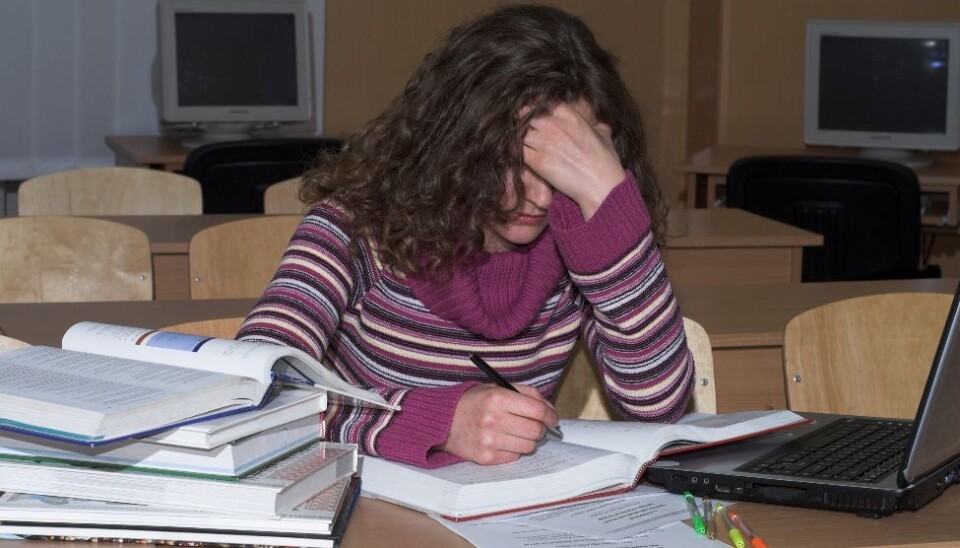
One in three teenagers suffers chronic stress
A third of all Swedish 16-year-olds are seriously stressed out, according to a new survey. Nearly one in ten also had symptoms of acute burnout.
Denne artikkelen er over ti år gammel og kan inneholde utdatert informasjon.
The figures were presented in a new study from Stockholm University.
Thirty percent of the high school students said they were stressed to a degree that could be classified as serious.
Eight percent suffered so much that had they been adults, they would have qualified for a clinical diagnosis of burnout.
The problem was most prevalent among girls. Karin Schraml, a Stockholm-based researcher, thinks the findings clearly show the urgent need for programmes to help adolescents tackle everyday stress.

“Norwegian and Swedish teens are probably pretty much the same in this regard,” comments Catharina Elisabeth Arfwedson Wang, an Associate Professor of Psychology at the University of Tromsø (UiT).
“I think it’s upsetting that so many so-called resourceful children are stressed. They experience enormous competition for high grades, for admission to the best fields of study and to generally be successful.”
Half of girls are stressed
In three different studies, Schraml surveyed the psychological condition of 16-year-olds at Stockholm high schools.
These schools were all high-ranking, where teens were being prepared for university studies and academic careers.

The students were asked to report their perceived conditions. Schraml also compared their responses to their grades at the end of the school year to detect a correlation.
The results were disheartening.
Thirty percent reported serious stress symptoms such as fatigue and concentration problems. Fifteen percent reported that their conditions had been long-lasting and eight percent had severe problems which in adults could contribute to a clinical diagnosis of fatigue syndrome, or burnout.
The chronically stressed group also received much poorer grades than those who were not stressed.
While the study showed that one out of five boys struggled with stress, nearly half the girls were plagued by stress.
“We wonder what it is that makes these problems more prevalent among girls,” says Ingunn Skre, who is also an associate professor at UiT.
“We know that some people are biologically more vulnerable to anxiety and depression, but it is often triggered by some sort of strain. We females have something in us, a trait probably passed down from our primitive ancestors, which tends to make us more vigilant, anxious and jittery, so we are more susceptible to these problems than males.”
Physical and psychological consequences
Stress can be defined as the perceived lack of sufficient resources to tackle ordinary daily challenges. Stress is not the same as depression or anxiety, but it can be a precursor to more serious mental disorders.
Stress can also result in physical effects, including making us more susceptible to disease, burnout or sleep problems.
Schraml's studies suggest that factors such as low self-esteem, insomnia, the perception of being subjected to difficult demands and insufficient social support could explain why the youths were stressed.
Sleep disorders are not just caused by stress, but can also be the cause of stress. A lack of sleep also has a negative effect on the students’ grades, according to the study.
A high degree of social jetlag – a big disparity in sleep patterns between weekdays and weekends – was also linked to poorer grades at the end of the school year.
Harmful competitiveness
“We notice that everyone tends to be more stressed these days. We have a faster pace, face bigger expectations regarding performance and, significantly, are subjected to a much more massive flow of information. Social media never give us a break. We have to be accessible at all times,” says Catharina Wang.
She thinks part of the explanation for the problems that stress today's teens can be found in modern society.
“Human beings are adapted to living in small groups, but the world isn’t like that anymore. We used to compare ourselves to our neighbours. Now we compete against everyone, from schoolmates to contestants on the TV show Idol,” says Wang.
“We’ve developed a competitive and comparative mentality which might explain why the inhabitants of an otherwise beneficial country like Norway can suffer so much stress and mental problems.”
Ingunn Skre says that Norwegian studies show a mounting number of youth who have problems with anxiety and depression.
“At any given time, young people experience an array of conflicting demands. They can get trapped in an impossible situation, where they have to excel in school, be cool, be simultaneously chaste and sexually experienced. This can be hard to handle,” she says.
Are elite, academic teens representative?
The Swedish researcher admits to certain reservations regarding her results. The fact that all the students were from elite high schools in the capital city can be a source of error, she writes. It’s obviously conceivable that these teens encounter more stress than their peers elsewhere, or compared to kids with other socioeconomic backgrounds.
Despite such considerations, Schraml asserts her findings fit well with previous national surveys.
This study mainly focused on school life. Other factors, such as trauma, problems at home and social rejection outside school could slip under the radar.
In any case, other factors would only affect the reasons for the stress, not the fact that the teens suffer it.
Focus on sleep
“We have a critical need for developing practical interventions that can reduce chronic stress among youth,” says Schraml.
Schraml described a research project in which she and a colleague tried out a combination of initiatives among youths, including cognitive behavioural therapy, mindfulness training and consciousness-raising about stress and sleep requirements.
She writes that she was particularly surprised by how little the teens knew about the importance of sleep to help prevent stress.
She thinks this is an area where informational and interventional initiatives can play a positive role.
Translated by: Glenn Ostling


































